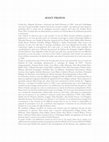Papers by Mila Andonova

Burial rush matting: integrated analysis of a twilled mat fragment from the Thracian Kitova tumulus (South-East Bulgaria)
Vegetation History and Archaeobotany, 2022
Basketry, matting and cordage were part of the material culture of past societies, but usually in... more Basketry, matting and cordage were part of the material culture of past societies, but usually in most cases these materials are poorly preserved, unless special conditions like waterlogging, desiccation or salt play a key role in the depositional environment. This paper presents such a case study, dealing with the detailed analysis of a twilled burial mat fragment originating from the Kitova mound (second century AD-first half of third century AD) – a tumulus situated in eastern Thrace, Bulgaria. The reduced oxygen conditions inside the burial mound and the contact with metal corrosion products ensured the remarkable preservation of plant material forming the mat in a desiccated state and allowed the application of an integrated set of analytical techniques. This instrumental approach combined Light Microscopy (LM), Scanning Electron Microscopy (SEM) and X-ray Electron Dispersive Spectroscopy (EDS). The matting technique was identified, being diagonal twilling, and the presence of spiny rush (Juncus acutus) as the raw material chosen for weaving the mat was confirmed; a possible local origin of the matting plants was suggested. It targeted the technological and taxonomical identification of the studied mat fragment and its archaeological interpretation. The design of this study remains flexible and could be successfully applied to archaeological basketry remains across different periods and geographical regions.

The Missing Woodland resources: Archaeobotanical Studies of the Use of Plant Raw Material. Advances in Archaeobotany 6, 2021
ance of mat-impressions on ceramic vessels to the Late Neolithic (LN) in the region and listed se... more ance of mat-impressions on ceramic vessels to the Late Neolithic (LN) in the region and listed several LN settlements, where mat-impressions were recorded (Fig. 1). He noted the tradition of impressing mats on pottery bases continued during the Chalcolithic of the Sofia Plane and added a few more Chalcolithic sites, which presented such impressions. Petkov (1965) did not classify the registered weaving techniques, upon the impressions, but only commented on the level of conciseness they showed. In terms of the weaving process, he implied that LN matweaving was performed on looms, and not manually. He supported his statement with an ethnographic observation (contemporary to his work in the 1960s) of mat-weaving on a loom, where cattail leaves (Typhaceae) were employed as wefts (ibid.). Petkov (ibid.) also found an additional indirect argument for his loom-weaving hypothesis in the perforated matimpressed base from LN Chelopechene transformed into a loom weight (ibid.; Fig. 1). However, he made suggestions for the plant material chosen for making mats, stating that the LN weaves were made with stems of cereal plants and not aquatic plants (1965: 49), while the Chalcolithic mats-of aquatic plants and particularly-cattails (ibid: 51). The author (ibid.) observed that in the LN impressions often two types of "cereal stems" were being interwoven, and based on the stems' diameter, proposed that einkorn stems (Triticum monococcum) correspond to the thinner stems and his main arguments were the einkorn
Heritage Science, 2021
This study proposes non-destructive assessment instrumentation, the X-ray MicroCT scanning, to ev... more This study proposes non-destructive assessment instrumentation, the X-ray MicroCT scanning, to evaluate archaeological basketry remains prior to any destructive analysis. Three case studies are originating from two archaeological sites in Southeast Europe, with three different stages of preservation (poor, sufficient and very good). In addition, there are two preservation modes-charring and desiccation-along with two conservation situations: treated and untreated with conservation agent fragments. The three different scenarios were chosen to explore the potential range of X-ray MicroCT scanning technology when applied to monocotyledonous small-sized archaeological remains. It was proved that this non-invasive X-ray method is particularly suitable for the often-disadvantaged ancient basketry remains.
Pots on Mats: Mat-impressed Salt-extraction Pottery at the Chalcolithic Provadia-Solnitsata, Bulgaria
Antiquity, 2021
Evidence for both basket weaving and salt production is often elusive in the prehistoric archaeol... more Evidence for both basket weaving and salt production is often elusive in the prehistoric archaeological record. An assemblage of Middle–Late Chalcolithic pottery from Provadia-Solnitsata in Bulgaria provides insight into these two different technologies and the relationship between them. The authors analyse sherds from vessels used in large-scale salt production, the bases of which bear the impression of woven mats. This analysis reveals the possible raw materials used in mat weaving at Provadia-Solnitsata and allows interpretation of the role of these mats in salt production at the site. The results illustrate how it is possible to see the ‘invisible’ material culture of prehistoric south-eastern Europe and its importance for production and consumption.
Comptes rendus de l’Academie bulgare des Sciences, 2021
This study was conducted side by side with the ongoing rescue trail trench-ing of Late Neolithic-... more This study was conducted side by side with the ongoing rescue trail trench-ing of Late Neolithic-Early Chalcolithic (LN-EC) settlement site at Varbishki dol in Western Bulgaria and its main goal was to test and present the potential of early sampling for bio-archaeological analysis and particularly-for the archaeobotany. The obtained results provided a signal for the LN-EC crop exploitation, including processing and consumption of cereals and pulses. This initial archaeobotanical data will serve as a fundament during the analysis of the bio-archaeological samples-to-be extracted from the forthcoming full excavation campaign at this prehistoric site.
Gräser, Bast, Rinde – Alleskönner der Steinzeit / Grass, Bast, Bark – Stone Age All-Rounders, 2020
Études Crétoises 37, 2019
by Mila Andonova, Katja Sporn, Stefan Biernath, Themistoklis Bilis, Anne Fohgrub, Johanna Fuchs, Dimitris Grigoropoulos, Nils Hellner, Hristina Ivanova-Anaplioti, Eric Laufer, Maria Magnisali, Wolfgang Rabbel, Katharina Rusch, and Hristina Ivanova The first report on the excavations and geophysical prospections at the sanctuary of Kalapodi (an... more The first report on the excavations and geophysical prospections at the sanctuary of Kalapodi (ancient Phokis/Greece), in order to trace the outline, setting and layout of the ancient sanctuary. The report includes studies by various authors, also on issues of restoration and presentation of the site.
Hypotheses (ArchéOrient - Le Blog), 2017
Drafts by Mila Andonova
Books by Mila Andonova

by Maud Devolder, Maria Emanuela Alberti, Gianluca Cantoro, Tristan Carter, Thérèse Claeys, Sylviane Déderix, Thibaut Gomrée, Valasia Isaakidou, Marie-Philippine Montagné, Eleni Nodarou, Apostolos Sarris, Rena Veropoulidou, Ilaria Caloi, Maria Anastasiadou, and Mila Andonova This book offers the final publication of a Protopalatial edifice excavated by André Dessenne nea... more This book offers the final publication of a Protopalatial edifice excavated by André Dessenne near the Palace at Malia in 1960. The architectural study of the ruin and the detailed presentation of the material discovered by the archaeologist allows a better understanding of the role of the Dessenne Building in the settlement at the beginning of the 2nd millennium BC. Complemented by a series of archaeological soundings, the present research also provides original data regarding the occupation of Malia during the Prepalatial period, including late 3rd millennium BC large-scale levelling works that prefigurate the construction of the Protopalatial Palace. Architecture, ceramic, stone vases, weights and tools, seals and sealings, and archaeozoological and archaeobotanical remains are studied by specialists whose research coalesce into a synthesis on the Bronze Age site development. This book thus not only offers the detailed presentation of an elite structure, it sets it into a broader historical perspective and offers a revision of the Pre- and Protopalatial sequence of the occupation at the core of the settlement of Malia.
Cet ouvrage offre la publication définitive d’un ensemble architectural protopalatial découvert en 1960 par André Dessenne aux abords immédiats du palais de Malia. L’étude architecturale de la ruine et la présentation détaillée du matériel mis au jour par l’archéologue permettent de considérer le rôle du Bâtiment Dessenne au sein de l’établissement au début du IIème millénaire av. J.-C. Complétées par de nouvelles fouilles, les recherches à l’origine de cet ouvrage produisent également des données inédites sur l’occupation de Malia au Prépalatial et sur les grands travaux d’aménagement de la fin du IIIème millénaire qui préfigurent la construction du palais au Protopalatial. Architecture, céramique, vases, poids et outillage en pierre, sceaux et scellés, faune terrestre et marine et restes archéobotaniques sont envisagés par des spécialistes dont les travaux produisent une synthèse importante sur le développement du site à l’Âge du Bronze. L’ouvrage présente ainsi de manière détaillée un édifice minoen d’élite tout en l’insérant dans une perspective historique plus large, en offrant notamment une révision de la séquence pré- et protopalatiale au cœur de l’établissement maliote.
Conference Presentations by Mila Andonova
The Significance of Archaeological Textiles (24 - 25. 02. 2021, Online), 2021

INTEGRATED MICROSCOPY APPROACHES, READING 2020, 2020
The Coiled Basketry The Neolithic pile dwelling settlements along the Lake Constance have yielded... more The Coiled Basketry The Neolithic pile dwelling settlements along the Lake Constance have yielded numerous basketry and textile remains of vegetal origin, preserved under waterlogged conditions and studied by the THEFBO Project. One of the most popular basketry techniques registered amongst this type of perishables was coiling. Coiled basketry (Fig. 1) items were created with two major functional elements: coils (forming the body of the vessel) and binders (wrapping around the coils and binding them together). Usually, the coils were formed of a bundle of different plant parts, including stems, leaves, and/or thin wooden/bark splints-all possessing the required rigidity in order to stabilise the basket's construction (Fig. 2). On the other hand, binders were usually formed of thin strips of wood bark and rarely of narrow leaves/stems-all of them sufficiently flexible to perform a 360°wrapping (Fig. 3).

18th CONFERENCE OF THE INTERNATIONAL WORKGROUP FOR PALAEOETHNOBOTANY
This investigation discusses original information on the ethnoarchaeology of agro-ecological farm... more This investigation discusses original information on the ethnoarchaeology of agro-ecological farming systems in the community of Nizag, located in the Andes of Ecuador. Suggesting hypotheses for the interpretation of archaeo-botanical record, on how Andean Kichwas societies are organized for the management of their subsistence vegetable economy. The research shows the probability of identifying certain cropping systems and agroecological practices, based on the biostatistical analysis of the taxonomic composition of carpological assemblages. It also shows how these Andean societies have developed a model of "agro-ecological diversification" for the management of their subsistence vegetable economy, in which the production of their crops goes beyond agriculture and the domestication of plants, because societies appropriate their agrobiodiversity according to the realities of their own needs, in addition to the regularities that these exercise over contingencies socio-ecological materialized in its agrarian landscape.
Annual Meeting of the Archaeological Institute of America (AIA) , Toronto, Ontario (January 5-8), 2017
Building Bridges. Abstract book of the 23rd Annual Meeting of the European Association of Archaeologists , 2017
This presentation proposes an integral approach towards the identification and reconstruction of ... more This presentation proposes an integral approach towards the identification and reconstruction of production techniques applied to plant material employed in ancient mat-weaving . The approach has been tested within a case study of the mat fragments from the Kitova mound (2 century AD, Thracian Valley, Bulgaria), which were preserved by desiccation due to the specific micro-climatic conditions of a sealed burial mound .
24th Annual Meeting of the European Association of Archaeologists. Barcelona 5-8 September 2018. Reflecting Features. Abstract Book Volume 1, 2018
Mat/basketry impressed pottery is relatively common within the Neolithic ceramic assemblages of t... more Mat/basketry impressed pottery is relatively common within the Neolithic ceramic assemblages of the Balkans. This presentation
focuses on examples from diverse Neolithic sites of Bulgaria and Greece, viewed through a botanical perspective, where the plant
material, chosen for weaving mats or basketry objects, which left their impressions on the pottery fragments, will be examined.
The lack of diagnostic plant morphology within the impressions shapes the study of this type of archaeological material, which is
ultimately very challenging.











Uploads
Papers by Mila Andonova
Drafts by Mila Andonova
Books by Mila Andonova
Cet ouvrage offre la publication définitive d’un ensemble architectural protopalatial découvert en 1960 par André Dessenne aux abords immédiats du palais de Malia. L’étude architecturale de la ruine et la présentation détaillée du matériel mis au jour par l’archéologue permettent de considérer le rôle du Bâtiment Dessenne au sein de l’établissement au début du IIème millénaire av. J.-C. Complétées par de nouvelles fouilles, les recherches à l’origine de cet ouvrage produisent également des données inédites sur l’occupation de Malia au Prépalatial et sur les grands travaux d’aménagement de la fin du IIIème millénaire qui préfigurent la construction du palais au Protopalatial. Architecture, céramique, vases, poids et outillage en pierre, sceaux et scellés, faune terrestre et marine et restes archéobotaniques sont envisagés par des spécialistes dont les travaux produisent une synthèse importante sur le développement du site à l’Âge du Bronze. L’ouvrage présente ainsi de manière détaillée un édifice minoen d’élite tout en l’insérant dans une perspective historique plus large, en offrant notamment une révision de la séquence pré- et protopalatiale au cœur de l’établissement maliote.
Conference Presentations by Mila Andonova
focuses on examples from diverse Neolithic sites of Bulgaria and Greece, viewed through a botanical perspective, where the plant
material, chosen for weaving mats or basketry objects, which left their impressions on the pottery fragments, will be examined.
The lack of diagnostic plant morphology within the impressions shapes the study of this type of archaeological material, which is
ultimately very challenging.
Cet ouvrage offre la publication définitive d’un ensemble architectural protopalatial découvert en 1960 par André Dessenne aux abords immédiats du palais de Malia. L’étude architecturale de la ruine et la présentation détaillée du matériel mis au jour par l’archéologue permettent de considérer le rôle du Bâtiment Dessenne au sein de l’établissement au début du IIème millénaire av. J.-C. Complétées par de nouvelles fouilles, les recherches à l’origine de cet ouvrage produisent également des données inédites sur l’occupation de Malia au Prépalatial et sur les grands travaux d’aménagement de la fin du IIIème millénaire qui préfigurent la construction du palais au Protopalatial. Architecture, céramique, vases, poids et outillage en pierre, sceaux et scellés, faune terrestre et marine et restes archéobotaniques sont envisagés par des spécialistes dont les travaux produisent une synthèse importante sur le développement du site à l’Âge du Bronze. L’ouvrage présente ainsi de manière détaillée un édifice minoen d’élite tout en l’insérant dans une perspective historique plus large, en offrant notamment une révision de la séquence pré- et protopalatiale au cœur de l’établissement maliote.
focuses on examples from diverse Neolithic sites of Bulgaria and Greece, viewed through a botanical perspective, where the plant
material, chosen for weaving mats or basketry objects, which left their impressions on the pottery fragments, will be examined.
The lack of diagnostic plant morphology within the impressions shapes the study of this type of archaeological material, which is
ultimately very challenging.